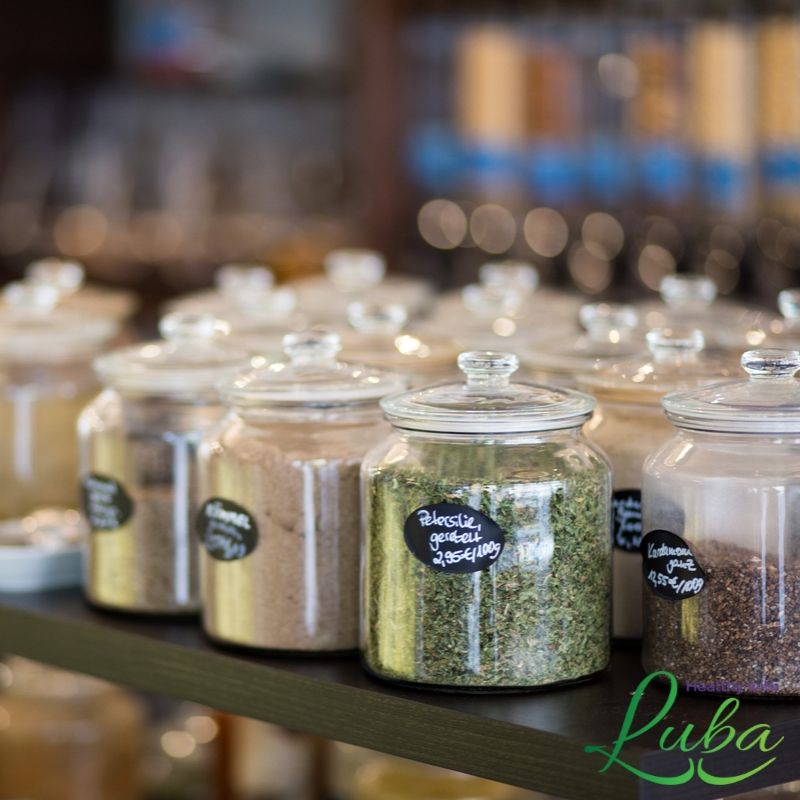
It’s not a necessary evil! Eating healthy is a part of good stewardship, and I wish I had learned that sooner.
While healthy food may seem pricey, here are some points to ponder for perspective:
- Realize that your grocery shopping in an investment in your health.
- You can get more for your money by purchasing healthy food.
- Eating unhealthy is expensive. Junk foods is not inexpensive; when you add doctor’s bills a year or ten down the road, it’s definitely not worth it.
- There are worse things than groceries on which to spend your money. (Think: hospital bills, doctor’s bills, the newest gadget that will be forgotten in a month or two . . . )
That being said, most of us do not have unlimited funds for groceries. That is all right because even on a budget it’s possible to eat healthy.

1. Use the bulk section in the store.
I like utilizing the bulk section at our local co-op. Because you are not paying for packaging, you are often saving money. Spices, flour, nuts, and much more can be purchased from the bulk section at lower prices without compromising quality.
Buying from the bulk section saves you money because you are not limited to package sizes. For example, if you need only one teaspoon of cinnamon, you can purchase that small amount.
For items you do use in larger quantities, watch for sales in the bulk section.
2. Purchase frozen fruits and vegetables.
Frozen fruits and vegetables are money savers in multiple ways. First, you can purchase an entire pound of vegetables and use it at your convenience without it going to waste. Second, the produce is ready to use. You are not paying for parts that you would normally discard.
Third, you are getting more nutrition for you money because frozen fruits and vegetables were harvested ripe and quickly frozen. Unlike the apples that were harvested green and transported from Washington to Texas where you finally purchased them, they have more nutritional value.
I love using frozen vegetables in soups; they are also delicious roasted in an oven with some olive oil.
3. Know prices.
Some people recommend a price book to compare prices of different foods in different stores.
Whether or not you keep a price book, know what is a good price for the various foods you purchase regularly.
Do beware of “sales” on foods that are not on sale. For example, I saw organic squash on sale for $1.19 per pound at a store. The next week, it was on sale for $1.99 per pound. Needless to say, I did not purchase any for $1.99 per pound!

4. Purchase whole foods.
Meat, vegetables, and fruit cost little in comparison to processed junk foods. For example, on Target.com, a 10-ounce bag of potato chips costs $3.99. That is $6.38 per pound. You can purchase organic chicken and sometimes beef for less than $6.38 per pound.
Furthermore, the entire bag of potato chips will not fill you up. The meat will be an excellent addition to a soup, salad, or casserole.
When you are purchasing prepared foods, you are paying for someone to cook or process them for you; you are also paying quite a bit for the packaging.
5. Eat at home more.
My husband and I love to eat at home because we have more control over what we are eating. It is difficult to find restaurants that offer healthy foods. Also, at a restaurant, you are paying someone to do your grocery shopping, cooking, serving, and cleanup.
6. Shop at more than one store.
If at this stage of life it makes sense for you, shop at more than one store. Some stores have better prices on produce and others on bulk foods.
If you are comparing prices, be sure to compare quality as well. Often it’s worth it to pay just a little more for much better quality! Sometimes the quality item actually may cost less!
7. Think ahead.
You should never be shopping only for that week. Know the regular price of the foods you normally buy. If there is a significant sale, purchase enough of that product to last you several weeks.
Products such as nuts, frozen fruits and vegetables, meat, and spices are good to purchase in advance, as long as they are stored properly. Spices can be kept in the freezer to retain quality. Meat can also be frozen.
If you found value in this article, please use the social media buttons below to share it with your network.
If you would like to be the first to be notified of new articles like this, just enter your name and email below!
One of the things we do to make the most of our food budget stretch is to shop the store in a specific order. That way we make sure we get the most important items and do not “run out” of money. We go first to produce, then meat, next dairy, afterwards frozen foods, and then bread. Once those items are in the cart we go to the entire aisles such as condiments, baking, canned items, etc. A rule we try to follow is 2 is 1 and 1 is none. We will buy 3 packages of butter and once it is down to 1 we purchase 2 or 3 more so that we never run out, can buy when the price is good, and also do not overbuy either.
It’s so true that buying snacks costs just as much as buying meat! It’s funny how people talk about how meat is so expensive but then buy multiple less-nutritional snacks.